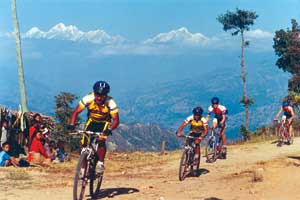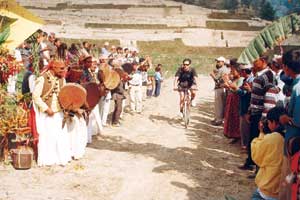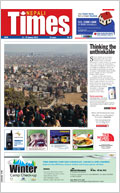 Around this time last year, the opening of the Siemens Action Asia Himalyan Mountain Bike Race Series 2001 hit Thamel. 'Hit' is perhaps the most appropriate way to describe the frenzy of activity, horse-drawn carts, dancing, parades and whistle-blowing. The people of Kathmandu Valley-high-ranking government officials, expatriates, local celebrities, onlookers and the VDCs of Sankhu, Lubhu and Kakani-all loved the festivities surrounding what is, after all, an event primarily for the overly energetic biking up and down the hills of the Valley.
Around this time last year, the opening of the Siemens Action Asia Himalyan Mountain Bike Race Series 2001 hit Thamel. 'Hit' is perhaps the most appropriate way to describe the frenzy of activity, horse-drawn carts, dancing, parades and whistle-blowing. The people of Kathmandu Valley-high-ranking government officials, expatriates, local celebrities, onlookers and the VDCs of Sankhu, Lubhu and Kakani-all loved the festivities surrounding what is, after all, an event primarily for the overly energetic biking up and down the hills of the Valley.  The races are back this year, with the opening ceremony in Thamel at 2PM on 22 November, and races the next three days.
The races are back this year, with the opening ceremony in Thamel at 2PM on 22 November, and races the next three days. The mud trails snaking up and down the hills surrounding the capital have long been popular with adventure sports athletes, especially mountain bikers. In addition to the splendid views of the Himalayas at this time of the year, the routes offer enough challenges and variety for many months of all-over sore muscles. A star German mountain biker, Marc Weichert, who won two races here last year, publicly extols the delights of off-roading in the Valley. After the competition last year, he told us: "It was better than racing in the European World Cup."
The sport is certainly a catching addiction, as evidenced by scores of young Nepalis who've taken it up.
Himalayan Mountain Bikes (HMB) was a major force in popularising mountain biking in the Valley with a well thought out long-term plan that included organising races and championships. "We had a five-year strategy which we started implementing in 2000. Basically, we've been working towards developing a truly international race," says HMB director Peter Stewart.
A keen biker himself, Stewart explains how HMB is lengthening the courses they recommend and take people biking on, and making them more difficult to help raise the standard of serious Nepali bikers. Like any business dependent on tourism, HMB has had its share of post-9/11 problems, but that hasn't dampened their enthusiasm for the races this year, or that of the participants'. The efforts made by the local communities to liven up the event with cultural programs and the mass welcome participants received upon entering each VDC did not go unnoticed.
As much as the quality of the biking, the involvement of the Valley's many communities has caught the attention of many international adventure sports channels and also National Geographic TV. "It was particularly due to the interest and support shown by the local VDC's that the television channels are returning this year," says Stewart.
 The average race time this year for the Men's and Women's Open category is expected to be between three and a half to at least four hours and the trails too have been made more difficult. "A lot of work has been put to study the courses. Participants will certainly find the course more challenging than last year," says race director Stewart. The Race 3 course from Nagarkot to Bhaktapur (see maps) is said to be the most challenging, and was 'discovered' by the German Ambassador, an avid biker. For Races 1 and 2, there are even camping facilities so, for a small cost, exhausted bikers don't have to ride all the way back from Sankhu and Nagarkot.
The average race time this year for the Men's and Women's Open category is expected to be between three and a half to at least four hours and the trails too have been made more difficult. "A lot of work has been put to study the courses. Participants will certainly find the course more challenging than last year," says race director Stewart. The Race 3 course from Nagarkot to Bhaktapur (see maps) is said to be the most challenging, and was 'discovered' by the German Ambassador, an avid biker. For Races 1 and 2, there are even camping facilities so, for a small cost, exhausted bikers don't have to ride all the way back from Sankhu and Nagarkot. Last year more than half the participants were Nepali, and HMB expects that to be the case this year too. The only trouble is money. The entry fees are not terribly high-between Rs 280 - Rs 2,200 for Nepalis, $20 -$ 80 for expats, and $190 -$270 for internationals-but there are other expenses built into participating in the races. "We've planned well for the races themselves, but the cost of logistical support and spare parts are often beyond reach for a normal Nepali," says one biker who says he may only be able to compete in one race.
In addition to three races in six categories, HMB is also doing something few sporting (and non-sporting for that matter) organisations do-making arrangements so people with disabilities can join in the fun. Like last year, the races this month will feature specially-designed courses for the disabled. This year, Handicap International will help meet the competitors' expenses and other needs. Twelve wheelchair athletes have already signed on.
(For more details, ring Himalayan Mountain Bikes 442345, 9810.33865, or email [email protected])


